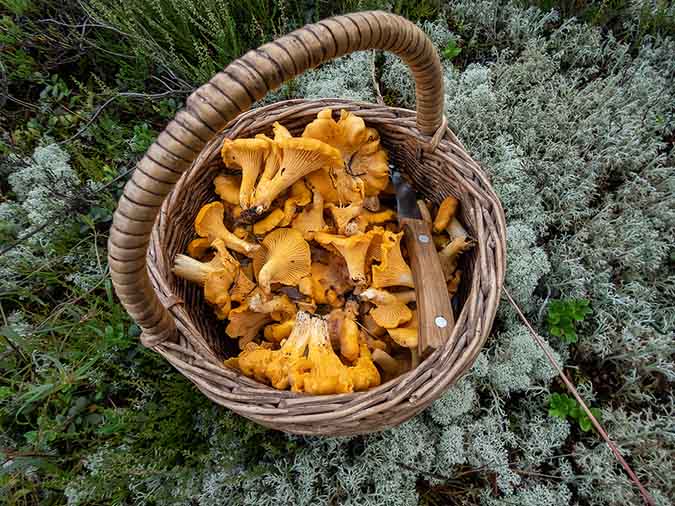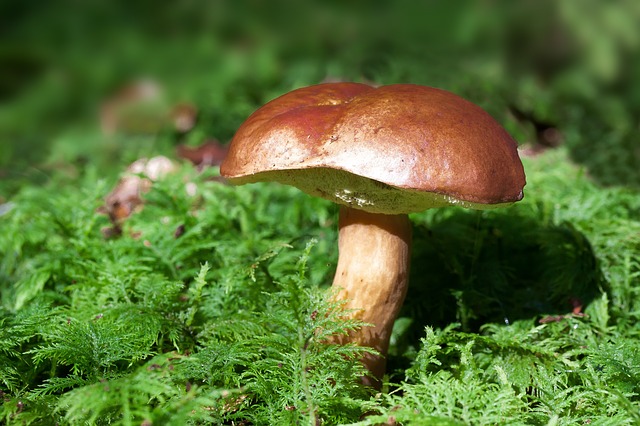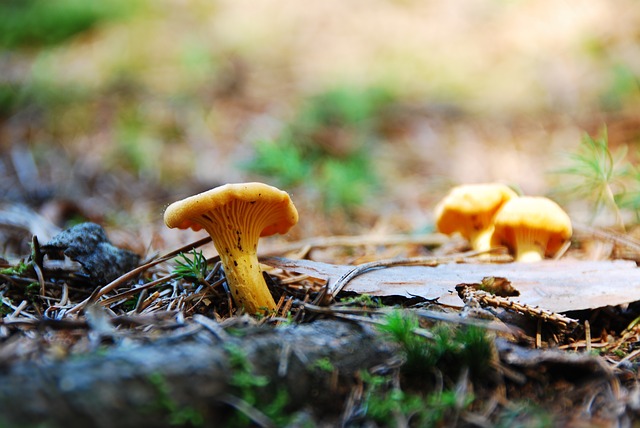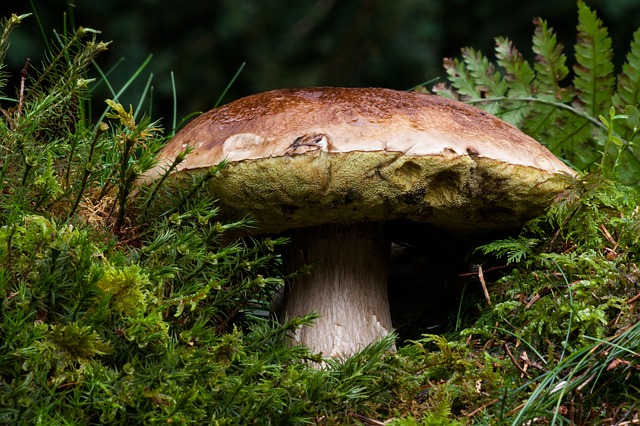Mushrooms can be deadly, so it’s essential to know exactly what’s what. Here’s how to stay safe while you get started with mushroom foraging.

How I Got Started With Mushroom Foraging
A few years ago I got on a mushroom-foraging kick. I don’t know why these fevers hit me occasionally, but I go through manic obsessions that drive me into strange hobbies for weeks at a time. For a few weeks earlier this year, I carved a pile of wooden spoons from green wood. At another point, I became obsessed with collecting Dioscorea species. And don’t get me started on my ill-fated teenage foray into plastic canvas.
Back to mushroom foraging.
It was a wetter-than-usual North Florida fall and I was running a small plant nursery, taking my plants to a couple of farmer’s markets on 2 days of the week and enjoying the cooler weather.
Something else was also enjoying the cooler weather. Mushrooms. They were everywhere, but they were particularly abundant in the oak-shaded pasture where one of the farmer’s markets was located. For multiple weeks, the ground was covered with huge, thick, brown mushrooms. Though I had foraged for wild plants for years, I had never gotten into mushroom foraging.
You May Also Enjoy:
“How to Not Die While Wildcrafting: 15 Rules for Foraging Safely”
Now, if you eat the wrong plant—with a few notable exceptions—you can burn your throat or end up with stomach issues. That’s bad, sure, and there are a few plants that will kill you dead, like water hemlock or oleander. Still, most plants are weak sauce compared to their fungal counterparts.
Eat the wrong mushroom, however, and it will basically melt your organs, even though it might taste and smell wonderful when you’re cooking it.
Fungi often contain some very scary toxins.
Only fools and madmen and hippies eat mushrooms without fear.

Image by Thanks for your Like • donations welcome from Pixabay
Yet there, right in front of me near the oaks, were multiple pounds of earthy, thick, beautiful, aromatic mushrooms, all ready to be sautéed with a good steak and served with Cabernet sauvignon.
Unless they were the organ-melting variety of mushrooms, which was a distinct possibility.
How DO you know which mushrooms are okay to eat and which ones are a one-way trip to renal failure?
I had to know. The fever hit me, and while in its clutches, I was powerless to resist the call of Cthul… I mean, mushrooms.
I started my mushroom-foraging journey with a stack of books. As is my usual approach when learning about a new topic, I buy some of the top-rated books on the subject and then read through them. This is a great way to learn, as it allows you to soak up the collected knowledge of experts in a particular field.
If you want to learn oil painting, for example, you can go hit up Amazon.com, go to the “books” section, type in “oil painting,” then look for the books that pique your interest and have excellent reviews. This has been my go-to method of learning a new topic since Al Gore invented the Internet.
Start by Learning as Much as Possible
I did that with mushroom foraging, bought a bunch of books, and can recommend the following:
- “All That the Rain Promises and More: A Hip Pocket Guide to Western Mushrooms”
- “Mushroom Demystified”
- “100 Edible Mushrooms”
- “National Audubon Society Field Guide to North American Mushrooms”
- “The Complete Mushroom Hunter: An Illustrated Guide to Finding, Harvesting, and Enjoying Wild Mushrooms”
- “Mycelium Running: How Mushrooms Can Help Save the World”
- “Organic Mushroom Farming and Mycoremediation: Simple to Advanced and Experimental Techniques for Indoor and Outdoor Cultivation”
- “Growing Gourmet and Medicinal Mushrooms”
- “Edible and Medicinal Mushrooms of New England and Eastern Canada”
If you can find someone you trust who will recommend books so you don’t have to buy quite so many, so much the better!
The first book I read on mushroom hunting opened my eyes to the huge variety of designs in the world of fungi. Did you know there are mushrooms with gills and mushrooms with pores? Or that some mushrooms will only grow next to certain trees, because they’re designed to only live in a symbiotic relationship with specific tree species? Others live only on decaying wood. Still others will actually kill trees.
Even stranger still, the mushroom itself, which most of us think is a sort of short-lived plant that pops up and then disappears, is actually just the fruiting body of a much longer-lived organism that is growing out of sight and can sometimes cover an acre or more of ground. Thin little mycellium, like tendrils twisting through the soil, are the real body of the fungi. The mushroom is just its means of reproduction, appearing only when climate conditions are right.
Later, as I read through more books, the world of mushrooms became more familiar and I started skimming over material that repeated what I’d learned in my previous reading.
Though North Florida isn’t considered to be a mushroom hunter’s paradise (cow-pie-searching hippies looking for a free trip to psychedelic dreamland notwithstanding), it isn’t the worst place in the world either. As I learned where mushrooms grow and how to spot them, I found some wonderful things. There were puffballs and hard, woody, bright-colored Ganodermas; chanterelles and boletes; strange shelf fungi; and even a big, bright-blue species known as Lactarius indigo which I found growing just a few hundred feet from my back door in a neighboring pasture.
Should You Eat That Mushroom?
But could I eat these mushrooms I was finding? Dare I even try?
I made myself some rules before I tried any.
First, if there was any chance I could get an identification wrong and poison myself, I would leave the mushroom alone.
Second, if I was absolutely sure the mushroom had no toxic look-alikes, I would only eat a little the first time—and always cook it.
Mushrooms with gills (meaning most of the common varieties that pop up in your lawn), are often harder to identify as “safe” than mushrooms with pores. I learned a few lessons about identifying edible boletes and was able to start enjoying them as an occasional addition to meals.
Fortunately, some species of edible mushrooms are so distinctive that there’s no way you’ll poison yourself—the wonderfully popular morel mushroom being a prime example. The aforementioned blue Lactarius indigo is another. I ate a few of those, though I was disappointed to find they weren’t as good as the common Agaricus bisporus for sale at Publix. On the other hand, when I found and ate chanterelles for the first time, I was wonderfully pleased to find they were much more delicious than any other mushroom I’d tried.
Here’s how to identify a chanterelle mushroom.

Image by Sandra_M_H from Pixabay
The #1 Rule of Mushroom Foraging
I wrote a good bit about mushroom hunting on my blog as well as recorded a few videos, which opened my eyes to just how crazy the mushroom-hunting world can be. Any little detail of mushroom hunting and identification is fought over endlessly. There’s almost no way to do any kind of writing or videoing on mushroom hunting that won’t have people coming out of the woodwork to explain why your methods are wrong and you’re going to die—or, alternately, that you’re being way too strict and that you’re missing the heights of culinary delight by cutting out (insert some random species here) from your foraging.
Mushroom people are weird. Though I suppose obtaining proficiency at a hobby that can quite easily kill you must take a certain personality type.
Something else I learned from my mushroom-foraging studies and later article writing is that people want to be told they can eat the mushrooms growing in their yard. I’ve been sent lots of photos of mushrooms in e-mails titled things like “edible???” and “mushroom id can i eat this?” I do my best to identify the species but I tell people NO! DON’T EAT IT UNLESS YOU KNOW FOR SURE IT WON’T KILL YOU!
You May Also Enjoy:
“Acorns: The Best Wild Food for Beginning Foragers”
“A Forager’s Guide to Running Out of Toilet Paper”
“Foraging for Wild Grapes (+My Old Family Recipe for Grape Hull Preserves!)”
If I share a composting technique and it doesn’t work out for you, no big deal. You just move on. But if I say “go ahead and eat that thing in the blurry photo you sent,” and you eat it and it turns out to be toxic, you could die.
I could probably kill a few hundred people just by writing an article titled “If A Mushroom Looks Pretty, Put It in Your Mouth!”
Maybe one day when my misanthropy finally overwhelms my charity, I will.
For now, though, I’ll stick to warning everyone that mushroom foraging can be a dangerous game. It’s certainly a lot of fun to learn about, though, and once you know a few sure-fire safe species, mushroom hunting becomes a lot like treasure hunting.
Do your reading first, though, and keep your organs intact.
What Do You Think?
What are your favorite books related to mushroom foraging? What are your best tips for beginners? Share them in the comments below!
___________
The Grow Network is a participant in the Amazon Services LLC Associates Program, an affiliate program designed to provide a means for our team to earn fees for recommending our favorite products! We may earn a small commission, at no additional cost to you, should you purchase an item after clicking one of our links. Thanks for supporting TGN!
David The Good is a Grow Network Change Maker, a gardening expert, and the author of five books you can find on Amazon: Compost Everything: The Good Guide to Extreme Composting, Grow or Die: The Good Guide to Survival Gardening, Totally Crazy Easy Florida Gardening, Create Your Own Florida Food Forest, and Push the Zone: The Good Guide to Growing Tropical Plants Beyond the Tropics. Find fresh gardening inspiration at his website TheSurvivalGardener.com and be sure to follow his popular YouTube channel.








COMMENTS(1)
It’s Spring where I live, and Chicken of the Woods (Laetiporus sulphureus or Sulfur Shelf) is ready for harvest.
A local foyager made us aware of the abundance of we had on our property a few years ago. He claimed Chicken of the Woods is safe when harvested from dead and dying Oaks, although other trees produce it. There is one toxic look-a-like that has ribs on its underside, compared to the pores COTW has.
Chicken of the Woods MUST be cooked someway before eating.
We live in the deep south. To me, our COTW tastes more like crab with lemon than chicken. I’ve had it in WV, and in that area, COTW definately has a chicken vibe.
My favorite ways of preparing COTW are “Chicken-Fried” using spices and self-rising flour, sauteed in olive oil and ghee for a crispy crust . Another favorite is using lightly boiled COTW in ceviche. The COTW absorbs all those wonderful flavors while keeping its crab flavor.
That’s all I know about foraging mushrooms.